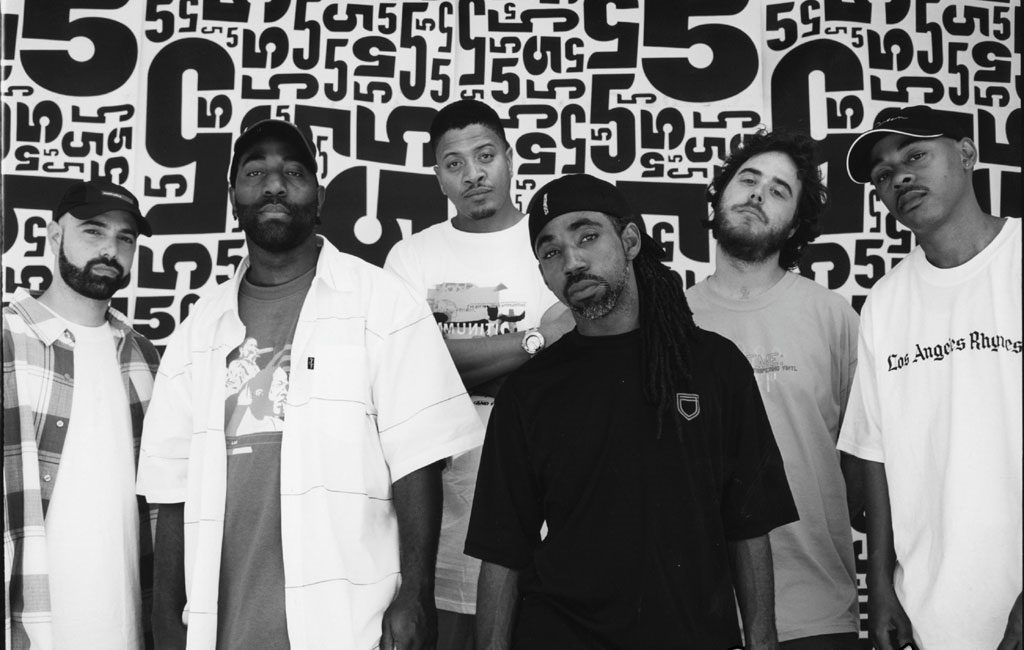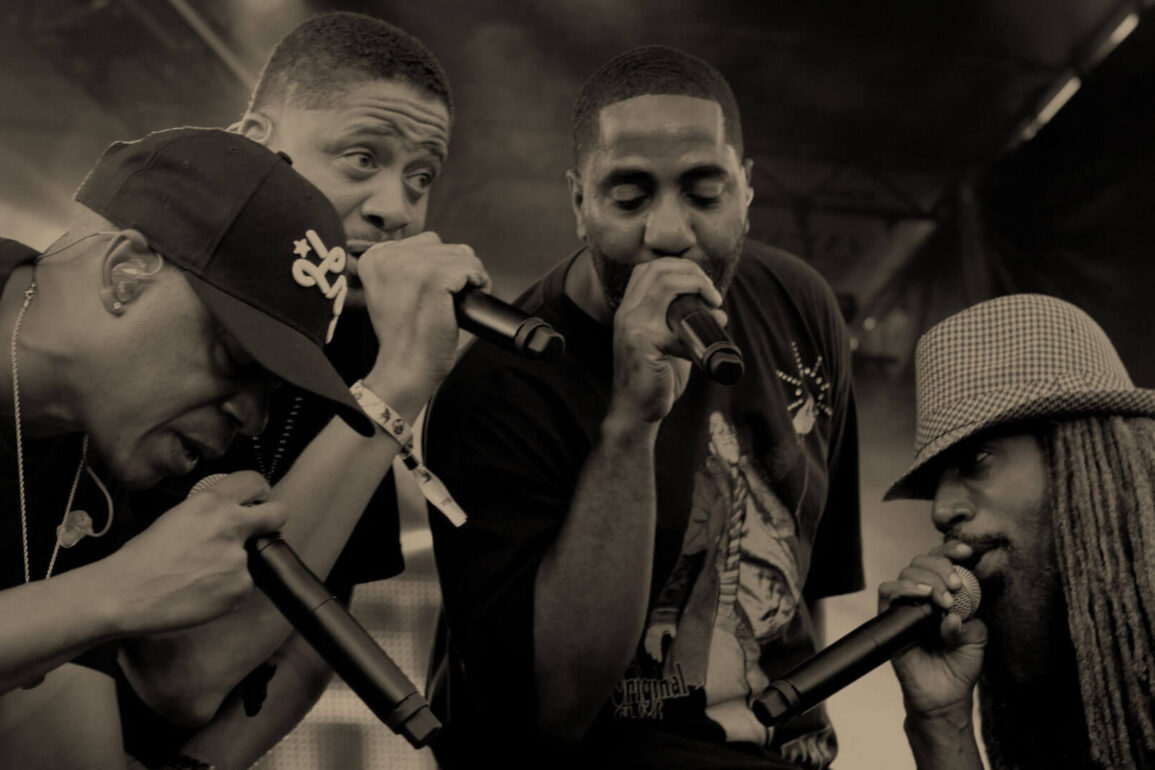
Jurassic 5 is a six-piece Hip Hop group from Los Angeles that came together in 1993, right in the middle of the West Coast’s gangsta rap dominance. J5 carved out a sound built on harmony, clarity, and rhythm where others leaned into aggression and street narratives. The group was born from two underground crews—Rebels of Rhythm and Unity Committee—and brought together MCs Chali 2na, Akil, Zaakir (aka Soup), and Marc 7even with DJs Cut Chemist and Nu-Mark, two producers with a deep respect for vinyl, timing, and texture.
Their music pulls from Hip Hop’s early blueprint: clean breaks, crisp scratching, and group rhyming that hits in unison or bounces between voices. Their 1997 self-titled EP laid the foundation, with tracks like “Concrete Schoolyard” and “Jayou” featuring sharp flows, bright horns, and drums that snap. From there, Quality Control (2000) sharpened their identity. The title track rides a bass-heavy groove and live-sounding drums, while songs like “Improvise” are full of confident, coordinated deliveries over jazz-flavored samples.
J5 leaned into group chemistry. Where many collectives feel fragmented, their structure works like a relay. One voice passes the baton, the next takes it without missing a beat. That sense of precision and shared timing gave their records a rhythm that felt lived-in and rehearsed without ever going stiff. On Power in Numbers (2002), the sound expands—more layers, deeper grooves, bigger ideas. Tracks like “What’s Golden” and “A Day at the Races” land with impact, with strong verses and beats that pull from funk and soul without slipping into nostalgia.
By Feedback (2006), the group had shifted. Cut Chemist left, and the sound tilted toward warmer melodies and polished hooks. Even with changes in lineup and tone, the crew kept their identity intact: clear voices, thoughtful writing, and beats that hit hard without clutter.
Jurassic 5 never relied on confrontation or status-chasing. Their energy came from rhythm and unity. Their live shows magnified that—call-and-response vocals, extended DJ routines, and a crowd locked into every line. After a long break, their 2013 reunion proved how deep their roots ran. Fans returned, word-for-word, because the music stayed direct, grounded, and alive.
The following list digs into 15 tracks that define what made Jurassic 5 essential—songs that carry weight through sound, structure, and sync.
15.Unified Rebelution (1997)
Before the polished harmonies and label deals, Unified Rebelution introduced Jurassic 5 with raw boom-bap grit and an underground spirit that hit like a live cipher. Released independently in 1997, their debut single came heavy with punchy drums, scratchy textures, and a dusty, sample-heavy beat built for concrete and vinyl. There’s an urgency here—part manifesto, part celebration—anchored by the group’s lyrical chemistry and seamless mic-passing.
Akil’s windmill cadences, Marc 7’s sharp confidence, and Chali 2na’s unmistakable baritone all crash through with youthful fire. The energy is communal, the mission clear: elevate the art form, pay homage to tradition, and move the crowd. Shouts to Cut Chemist and Nu-Mark hint at the deeper live show DNA to come, while the chorus chants and extended outros add a loose, freestyle feel.
It’s rugged, unfiltered, and bursting with intent.
14. Red Hot (2006)
“Red Hot” lives up to its name with a blistering pace, searing delivery, and a rhythm built for full-volume performance. The Dap-Kings sample—tense, funky, and wired with retro flair—lays the foundation for a barrage of tightly packed bars, with each emcee bringing high energy and sharp timing. Marc 7 opens with swagger and momentum, while Akil and Chali 2na fan the flames with vivid imagery and verbal snap.
Soup’s lines ripple with wit and control, anchoring the song with a slick, composed presence. The group moves in lockstep, bouncing off one another with fluid transitions and undeniable stage-readiness. It’s the kind of track that erupts live—fists up, feet moving. While Feedback drew mixed responses for its production shift, “Red Hot” stands out as a clear highlight: raw, animated, and full of heat. Jurassic 5 reminds listeners exactly why their voices command attention, no matter the backdrop.
13. The Game (2000)
“The Game” channels the intensity of basketball through tight wordplay, vivid imagery, and a knocking beat from Cut Chemist. From the opening whistle to the final buzzer, the track builds like a full-court press—fast-paced, aggressive, and relentless. The MCs trade verses packed with crossover moves, blocked shots, and crowd-roaring dunks, turning each bar into a play on the hardwood.
The production stays gritty and energetic, with bouncing drums and samples that echo the chaos of a packed arena. Chali 2na leads with his signature baritone, setting the pace with clever lines that snap like a chest pass. The others follow with precision, delivering rhymes that land like buzzer-beaters. A chorus of ad-libs and game-time references keeps the energy high without losing focus.
“The Game” doesn’t drift from its theme—it commits to it fully, pulling basketball and Hip Hop into the same frame and making every word count like it’s the last possession.
12. Action Satisfaction (1998)
“Action Satisfaction” rides a funky, uptempo break that never lets up. Cut Chemist drops a groove built for head-nodding and movement, letting each MC leap in with sharp bars and a grin behind the delivery. The track thrives on momentum—verses trade off in bursts, full of wordplay, pop culture jabs, and rhythmic gymnastics.
Rather than veer into cynicism or posturing, the song keeps its tone buoyant. The hook lays it out plainly: this is a crew rooted in energy and precision, delivering without gimmicks. There’s no posturing here—just bar-for-bar craftsmanship held together by tight interplay and a clear sense of joy in the process.
Whether it’s Akil flipping metaphors or Chali 2na gliding over syllables with his signature baritone, the whole thing pulses with vitality. “Action Satisfaction” is about movement, chemistry, and execution—wrapped in a sound that’s full-bodied and alive.
11. Lausd (2000)
“Lausd” walks a tight line between tribute and cautionary tale. Built on a funky, mid-tempo groove that gives a sly nod to MC Shan’s “The Bridge,” the track maps out Los Angeles through a lens both lived-in and wary. Cut Chemist lays down a head-nodder that rides easy, but the verses sharpen things up—pulling apart illusions of fame, fortune, and city mythology.
Each MC takes a corner of the map: the hustle, the heartbreak, the lure of stardom, the weight of expectation. It’s not about bitterness—just recognition. Behind the palm trees and premieres is a churn of ambition, and not everyone makes it out clean. There’s love in the verses, but it’s the kind that comes from knowing a place too well to glamorize it.
Even the hook resists ego: “We are no superstars…” Just working artists in a city that often forgets to look past the surface.
10. If You Only Knew (2002)
“If You Only Knew” flows with a calm, soulful backdrop—rounded bass, soft keys, and a steady rhythm that clears the way for some of Jurassic 5’s most open reflections. The mood leans inward, but never drifts. There’s purpose in every line, as each MC tackles image, expectation, and personal history with a sense of patience and care.
Chali 2na opens with precision, slicing through industry facades. Akil, Soup, and Marc 7 follow with verses that reject performance in favor of honesty—sharp without being bitter, grounded without slipping into cliché. Their delivery never overreaches, just speaks plainly and lets the weight sit.
The hook acts like a quiet rallying cry: they’ve been through it, and they’re still here—not asking for praise, just offering something real. From top to bottom, the track carries both craft and heart.
9. The Influence (2000)
“The Influence” is a quintessential Jurassic 5 track, displaying the group’s effortless chemistry and sharp lyricism. Over a soulful sample of The Hi-Lo’s “Some Minor Changes,” the beat bounces with crunchy drums and smooth, laid-back vibes, providing the perfect backdrop for the crew to flex their skills. Each member, from Zaakir to Chali 2na, brings their unique voice and style to the track, delivering tight verses that exude confidence and charisma.
Lyrically, “The Influence” critiques the shallow pursuit of fame in the rap game, calling out MCs more concerned with image than substance. Marc 7 even drops a line about “building you up to break you down,” while Chali 2na cleverly derides artists who chase quick success, only to falter. The track’s relaxed yet assertive tone makes it both a statement piece and an anthem for those who value authenticity over industry glitz. It’s timeless and infectious, capturing J5’s classic appeal.
8. High Fidelity (2002)
“High Fidelity” rides on a smooth, mid-tempo groove built from warm keys, crisp snares, and a subtle jazz loop that wraps the track in a laid-back glow. It’s a space where precision and mood meet—Zaakir and Marc 7 trading verses with balance, clarity, and ease. Each line feels measured but alive, full of inward focus and lyrical confidence.
The hook floats in like a mantra: “And together we will forever be / High fidelity, definitely…” It’s understated but effective, stitching verses together with harmony and poise. The production leaves room for the voices to breathe, and DJ Nu-Mark holds it down with a light touch on the fader, guiding transitions without overstepping.
Lyrically, the tone shifts between self-assurance and craft celebration—bars about penwork, sonic chemistry, and timeless elements of the culture. The fifth element of Hip Hop, the soul behind the structure, runs quietly through every beat. Nothing’s rushed. “High Fidelity” settles deep, steady in its conviction, content to let skill speak plainly.
7. Jayou (1998)
“Jayou” captures Jurassic 5 in raw form—fired-up, unfiltered, and fully in sync. Over a sample-heavy beat laced with jazzy horns, snapping snares, and frantic scratches, the crew launches into a high-octane display of rhythm and rhyme. The energy is immediate. Every line hits in rapid succession, emcees trading bars like a cipher caught on tape, no gaps, no stumbles.
The hook is more of a chant than a chorus, a crew declaration that sets the tone and circles back throughout. Each verse plays its part: Chali 2na’s baritone slides in steady, Akil and Zaakir inject fire, Marc 7 keeps things locked tight. The lyrical content flips from cosmic to comic—social digs, flexed vocab, punchlines and rebellion, all wrapped in flow.
There’s no hooky sheen, no breaks for breath—just rhythm stacked on rhythm. “Jayou” is like a mission statement from the underground, brash and full-bodied, where every voice counts and every beat demands movement.
6. Break (2002)
“Break” hits with purpose from the opening bar, built on a rugged foundation of chopped samples, jagged drum loops, and needlepoint scratches. The beat lurches forward with a raw, loop-driven tension, its minimalism giving space for the verses to strike clean and hard. Cut Chemist and DJ Nu-Mark set a stark stage—no gloss, just grit and rhythm.
The MCs sharpen their delivery to match. Akil opens with bite, followed by Chali 2na’s deliberate cadence and Marc 7’s cool precision. Lines unfold with coded references and tight rhyme structure, threading wordplay through themes of resilience and skill. Soup adds bounce and personality in his verse, balancing the track’s edge with style. Throughout, the chemistry is taut.
A lifted hook borrows iconic bars from Rakim’s “Lyrics of Fury,” flipped into a chorus scratched live—both a salute and a flex. Midway through, the instrumental strips down into a percussive loop that rides out with no vocals, just groove and static. It’s a moment of pure head-nod energy, a break in name and form.
“Break” leans into stripped-back power: bars over beat, message over noise. Every element lands with intent, stacking rhythm, tone, and delivery into a hardwired display of control.
5. Quality Control (2000)
“Quality Control” opens with the sound of a dusty groove and a steady drum roll, laying the groundwork for a song rooted in purpose and precision. The production is alive with character—Cut Chemist and DJ Nu-Mark craft a backdrop of crisp snares, warm piano loops, and sharp scratches. It’s the sound of crates dug deep and skills honed sharp.
The group enters in formation. Each MC delivers verses packed with technical finesse and layered wordplay, passing the mic in seamless rhythm. Akil sets the tone with lines that tap into themes of communication and craft. Zaakir follows with lyrical flair and vivid cadence. Marc 7 builds energy with punchy rhyme schemes, and Chali 2na anchors the track with his unmistakable presence. The hook ties it all together—bold, declarative, and laced with harmony.
“Quality Control” is driven by intent. Its verses push back against surface-level sound and empty spectacle, pointing instead to breath control, lyrical clarity, and historical awareness. References to SP-1200s, syllable structure, and poetic discipline run throughout, grounding the track in the tools and language of the art form.
This is a song built on movement—of sound, of spirit, of message. It moves heads and pens alike, while affirming the group’s mission with clarity and weight.
4. A Day At The Races feat. Percee P & Big Daddy Kane (2002)
A Day at the Races is a storm of verbal precision riding a groove-laced beat cut from vintage soul. Powered by Cut Chemist’s sharp ear for rhythm, the track throws down with heavyweight verses from Jurassic 5 and two seasoned guests: Percee P and Big Daddy Kane. It’s a posse cut packed with momentum, each voice carving into the instrumental with its own distinct cadence and flavor.
The energy opens with Akil’s call to arms, linking musical craft to legacy and resistance. The group’s signature vocal relay follows, steady and relentless, each MC handing off the mic like a live wire. Zaakir swings between wit and grit, while Chali 2na’s booming baritone slices through with calculated force. Percee P enters like a bolt of static—his rapid-fire delivery jittering across the beat with fierce control. Big Daddy Kane glides in next, confident and unapologetic, wielding his lines like a veteran with nothing left to prove.
Underneath the dense wordplay, the production stays locked in—dusty drums, sliced samples, and that constant low-end thump that drives the track forward without letting up. The cut appeared in Tony Hawk’s Underground, a perfect fit for its kinetic edge and breakneck pacing.
More than a throwback, A Day at the Races pulses with purpose. It’s urgent, unfiltered, and proudly in step with the roots of Hip Hop: lyrical dexterity, high-stakes rhythm, and a mic passed hand to hand like it means something.
3. Improvise (2000)
“Improvise” captures Jurassic 5 at their most playful and agile, fusing tight lyrical exchanges with a bouncing, funk-laced rhythm that never stays still for long. The beat is pure kinetic energy—brisk drum breaks laced with turntable scratches that zigzag around the verses, keeping things in perpetual motion. It’s an uptempo jam with a loose, live-wire spirit, tailor-made for cipher circles and street corners.
The track opens with a rapid-fire relay of two-bar handoffs between the MCs, each one tagged in by name and challenged to bring fresh bars to the mic. The chemistry is immediate and electric—Chali 2na, Akil, Marc 7even, and Zaakir each deliver quick hits of swagger, humor, and verbal craftsmanship, making their entrances feel like jump-rope landings in a game of lyrical double dutch.
“Improvise” leans into its title with conviction. The verses move like freestyles sharpened in practice sessions—fluid but focused, full of clever metaphors and sharp delivery. The chorus ties it all together with a nod to the early days of Hip Hop: “We’ll show you how to improvise / reminiscent of the Wild Style ’75.” That reference isn’t just a throwback—it’s a reaffirmation of the group’s love for spontaneity and crowd-rocking fundamentals.
As with much of J5’s catalog, the DJs play a central role. The cuts and scratches aren’t just adornments—they steer the rhythm and heighten the energy, especially in the breakdowns. The call-and-response vibe keeps things grounded in Hip Hop’s communal roots, while the constant lyrical rotation gives every voice room to shine.
Also notable is the song’s inclusion in Jet Set Radio, which helped introduce it to a wider audience, pairing its breakneck cadence with the game’s own high-speed, graffiti-tagging aesthetic. “Improvise” celebrates the act of creation itself, in real time and full color.
2. What’s Golden (2002)
“What’s Golden” bursts out of the gate with a high-energy funk loop that feels built for bright afternoons and open car windows. The beat, anchored by a deep, rubbery bassline and punctuated by short trumpet stabs, snaps into motion with precision and confidence. DJ Nu-Mark and Cut Chemist thread the rhythm with bounce and clarity, delivering a vibrant canvas for Jurassic 5’s tight vocal interplay.
The hook is immediately infectious—“We take it back to the days of yes y’allin’ / We holding onto what’s golden”—a chant that speaks to hip-hop tradition without sounding stuck in it. Each emcee delivers verses that hit with poise and craftsmanship. Zaakir opens with a slick display of poetic flair, painting with words rather than posturing with boasts. Marc 7even follows with pointed critiques of commercial excess, flipping phrases with ease and control. Akil and Chali 2na round out the lineup with verses that alternate between grounded philosophy and razor-sharp phrasing, all while keeping their voices locked into the beat’s pocket.
The track’s polish doesn’t dull its edge. There’s a clear sense of purpose behind each bar—whether in rejecting material flash, celebrating lyrical skill, or affirming the value of Hip Hop as craft. The production’s mood stays upbeat throughout, but the message carries weight. “What’s Golden” sounds celebratory, but it also functions as a mission statement: a call to maintain integrity in a space often driven by trend and image.
Sonically, this is one of J5’s most radio-friendly offerings, but nothing feels compromised. The pacing is crisp, the transitions seamless, and the chemistry between the four MCs remains intact. The beat may loop in familiar funk territory, but the delivery elevates it—turning a simple groove into something unmistakably theirs.
“What’s Golden” stands as a burst of affirmation. It’s not just about nostalgia or revival—it’s about holding steady, staying grounded, and moving forward without forgetting the roots.
1. Concrete Schoolyard (1998)
“Concrete Schoolyard” rides on a laid-back groove built from a simple but addictive formula: a dusty piano loop, crisp snares, and a bassline that moves with ease. DJ Nu-Mark and Cut Chemist keep the beat stripped down—looped from Ike Turner’s “Getting Nasty”—leaving space for the MCs to run their relay. The hook’s chant—“Let’s take it back to the concrete streets / Original beats from real live emcees”—lands like a manifesto, one that lays out J5’s mission in plain terms: raw lyricism, group energy, no gimmicks.
From the jump, the beat locks in and stays there. The production leans into repetition without falling flat, anchored by a groove you can nod to or dance with. There’s no flashy switch-ups or dense layering. That restraint works in the track’s favor—it highlights the cadence and bounce of the vocals without dragging the momentum. Around the 2:45 mark, a secondary sample from Disco Dave & the Force Five MC’s “High Power Rap” slips in, giving the outro a loose melodic lift, almost like the beat catching its breath.
Lyrically, this is Jurassic 5 in full cypher mode. The four MCs pass verses with clean precision, each one hitting different pockets in the rhythm without crowding the beat. Chali 2na’s baritone hits first, steady and grounded. His delivery feels anchored, never rushed. Akil follows with sharp, off-kilter rhyme patterns, slipping surreal references into the mix—“I walk from Tranzania, earthquake Transylvania”—without derailing the rhythm. Marc 7 and Zaakir round it out with lines that dart between punchlines, abstract wordplay, and sharp critiques of the music industry.
There’s no heavy concept or narrative to carry. The verses drift between swagger and homage, referencing science, history, politics, and neighborhood pride, all with a casual looseness. The structure is straightforward—intro, verses, chorus, outro—but the balance of groove and group interplay gives the track its staying power. Every line feels plugged into the rhythm. Every transition from one voice to the next hits clean.
“Concrete Schoolyard” feels built for warm weather, open air, and speakers that carry across streets. It’s a block party anthem with depth, rooted in technique but aimed at movement.
This post was originally published on this site be sure to check out more of their content.







